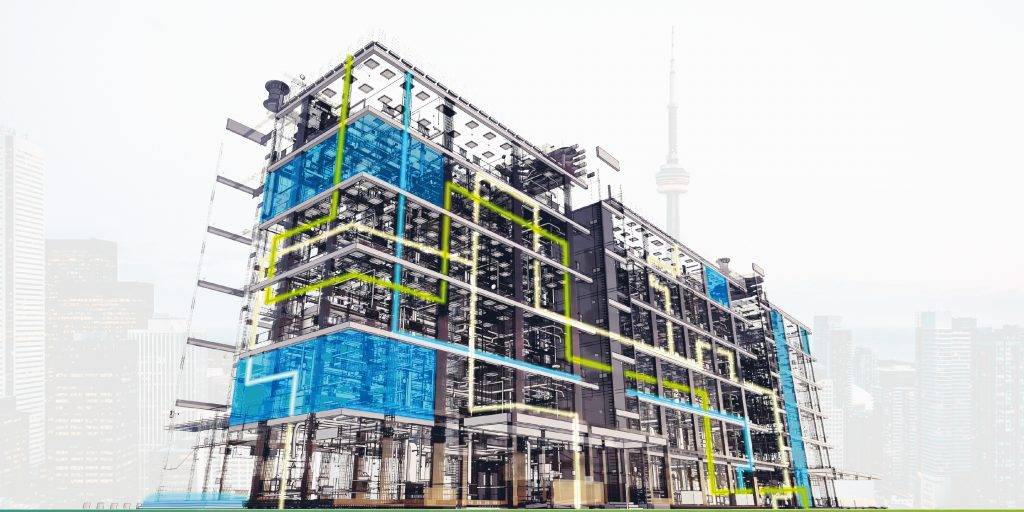
Smart building projects enable companies to utilize data innovatively to make crucial business decisions. By implementing technologies like IoT and other sensors, buildings can be optimized, monitored, and operated in real-time to provide employees with a safer working environment and visitors with a more pleasant building experience. This blog post will discuss the potential role of data-driven business models in developing the next generation of intelligent buildings.
Contents:
- What are intelligent buildings, and how do they enable data-driven business models?
- What do the project phases look like?
- Examples of data-driven business models for real estate operators
- Conclusion – How can investors benefit from the implementation of intelligent buildings?
After reading this article, you will better understand how digital buildings enable data-driven business models and create value for property operators. Smart building projects empower companies to collect and analyze data, resulting in informed decisions that enhance security, comfort, and overall visitor experience.
What are intelligent buildings, and how do they enable data-driven business models?
In a Computerwoche article, Bettina Tratz-Ryan, Research Vice President at Gartner, discusses the impact of Smart Buildings on data streams from facility management and individual usage patterns. While her insights are valid, they may not encompass all potential aspects that can arise during projects and operations. Tratz-Ryan emphasizes the importance of establishing ecosystems to integrate various asset management systems for facility management. However, successfully integrating, operating, and managing these platforms requires complex skills, data management, and innovation, often obtained through suppliers as part of professional services.
Intelligent buildings facilitate data-driven business models by continuously capturing information on energy consumption, space utilization, environmental factors, and other relevant parameters. These data are then analyzed and utilized to optimize building operations and maintenance, including heating, ventilation, lighting, and security systems adjustments. By integrating sensors, actuators, control systems, and communication technologies, buildings can support the collaboration between service providers, occupants, and energy suppliers, paving the way for innovative business opportunities. In doing so, all stakeholders benefit from reduced operating costs, improved spatial comfort, and a more sustainable utilization of available resources.
Why is investing in smart buildings worthwhile?
By harnessing modern technologies such as sensors, automation systems, and energy management tools, it becomes possible to reduce energy consumption, enhance residents’ quality of life, and achieve long-term cost savings. Moreover, it is crucial to think beyond the confines of individual properties and consider the potential benefits of digitizing entire neighborhoods or even cities. Stefan Beberweil, Managing Director of Qivalo GmbH, highlights in a report by MVV Energie AG: “The advantages of an intelligent data infrastructure are clear: increased security, enhanced control, improved well-being, and significantly reduced energy consumption. This is a worthwhile endeavor, and the existing energy and water supply infrastructure is a vital foundation. It can make buildings smarter and nurture the emergence of Smart Cities.”
What are the business benefits that can be achieved through digitized buildings?
Digitalized buildings offer numerous business advantages that can lead to increased efficiency and profitability. By integrating state-of-the-art technologies into building systems, such as sensors, smart lighting, and heating, companies can achieve significant energy savings that positively impact operational costs. Furthermore, digital buildings enable improved space utilization by providing real-time, detailed analysis of building occupancy. This allows businesses to manage better and adjust their office spaces to enhance employee productivity.
Moreover, enhancing security systems in digitalized buildings minimizes security risks and safeguards valuable company resources. The implementation of intelligent technologies also has the potential to enhance user well-being and satisfaction. Overall, digitalized buildings present diverse opportunities for companies to gain a competitive edge and enhance their business outcomes. This has a positive long-term impact on multiple factors, and we can already observe a positive trend towards this.
Data aggregation and analysis
Intelligent technologies are revolutionizing the architecture and construction industry by providing data-driven insights to optimize building performance. For instance, energy efficiency can be enhanced, and the comfort and well-being of occupants can be elevated through collecting and analyzing relevant data in digital buildings. This innovative approach bridges technological advancements with everyday life, paving the way for a new era of work. However, it also impacts the parties and organizations responsible for managing and leasing spaces. A Building Operating System (BOS) can be crucial in addressing these challenges.
In an interview with Jules Barker, Global Director of Product at WiredScore, Marc Gille, CEO of GMS Partners Thing-it, describes the objective as obtaining data that provides valuable insights for managing a portfolio of buildings. This data collection must demonstrate sufficient performance to analyze and process more specific building-related information. It goes beyond simply organizing BIM hierarchies like locations, floors, or rooms. The system requires an understanding of building semantics to leverage data analysis effectively. This would enable us to establish connections between physical data and business data, extracting meaningful insights from our buildings instead of relying on models from supply chains or financial markets.
What do the project phases look like?
In project management, “project phases” refers to a series of steps from start to finish. These pivotal stages ensure the organization and structuring of complex tasks, enabling proper project management. Typically, the process commences with an initiation phase, where goals, requirements, and outcomes are identified, followed by thorough preparation encompassing resource allocation and success strategies. Accomplishing complex objectives becomes much more accessible by breaking them into manageable segments in each process phase. After the planning phase, execution ensues, involving predefined activities to achieve the desired results. We enter a monitoring and control phase to ensure the project stays within the confines of time and budget, involving continuous assessments and corrective measures.
Setting goals
When embarking on a Smart Building or Digital Twin project, clearly defining your organization’s objectives is crucial. This will establish the parameters and expectations for success, enabling team members to plan their activities and coordinate resources effectively. By conducting thorough research on industry trends and customer needs, companies can develop strategies to achieve desired outcomes. Any changes or adjustments to project goals should be communicated and documented throughout the process to ensure alignment and collaboration among all stakeholders.
Utilize use cases and scenarios
Once the goals are established, the project manager or team should consider use cases and scenarios demonstrating how users interact with the digital building. These detailed plans help illustrate the various capabilities of the smart building or digital twin and identify areas for improvement. Use cases provide a comprehensive overview of how technologies will function in the real world while delivering valuable insights into system requirements and user experience. Each project is unique, but specific processes can be duplicated to save time.
Develop test plans
Testing is crucial in any project, and Smart-Building or Digital Twin projects are no exception. A well-crafted test plan should provide detailed instructions on verifying the expected functionality of all system components. This includes manual user tests and automated tests using software tools, such as performance checks and general quality assurance, standard practices in IT projects.
Deriving a business case
Creating a business case is crucial for demonstrating the project’s economic value and ensuring its alignment with corporate goals. This entails analyzing costs, benefits, risks, and other factors necessary to present a compelling argument for the project’s success. Once the analysis is complete, stakeholders can decide whether to proceed with the plans.
Informing and involving stakeholders
The success of a smart building or digital twin project often relies on the involvement of stakeholders. It is crucial to keep them informed throughout the process and ensure they understand how their role impacts the project’s progress and outcomes. This can involve regular meetings, email updates, and other necessary means to ensure all stakeholders are up to date.
Ensure alignment of the project plan with all parties involved
Once the goals, use cases, and other plans are determined, the project manager must develop a completion schedule. Important milestones should be set in coordination with all parties involved in the project, including suppliers, partners, and other stakeholders who will play a significant role in its success.
Thoroughly incorporate changes to project goals
Unexpected changes to project goals can make the difference between success and failure. To ensure accurate implementation of any alterations or adjustments to the original plan, regular progress monitoring must occur throughout the entire project duration. This includes reviewing all outcomes and gathering feedback from stakeholders and other project participants. Upon completion of all tasks and delivery of final results, resources are released, and insights gained along the way are documented for future reference, effectively concluding the project. Each phase of a project is unique, presenting its characteristics, obstacles, and objectives.

Therefore, it is crucial to comprehend and manage these stages meticulously to ensure successful outcomes. By implementing the best practices described above, project managers can ensure the timely and triumphant completion of their smart building or digital twin projects. It is important to note that project management processes are not static and may evolve due to changing business operations, requirements, or needs. Hence, it is imperative to regularly assess progress, review insights gained, and adapt plans to keep pace with the rate of change. Project teams should also consider external factors such as market fluctuations and economic variations when managing projects.
Examples of data-driven business models for real estate operators
The real estate market constantly evolves, and data-driven business models are becoming increasingly crucial for operators to succeed. This includes utilizing data to analyze local market trends, enhance pricing strategies, streamline operations, and gain insights into customer behavior. Here are some examples of data-driven business models that real estate operators can leverage:
- Predictive analytics: By harnessing predictive analytics, operators can identify high-value locations, forecast future demand, and gain insights into customer preferences. This enables operators to adapt their services, pricing, and marketing strategies accordingly.
- Automated leasing systems: Automated leasing systems facilitate faster leasing negotiations and automated approval processes, along with easy access to data on tenant profiles, creditworthiness, and payment history.
- Real-time property monitoring: Operators can utilize real-time property monitoring to detect irregularities or maintenance issues before they escalate into major problems.
- Real estate management software: Real estate management software solutions enable operators to manage multiple properties through a single platform, streamlining day-to-day tasks, tracking occupancy rates, and automating rent collection.
- AI-driven tenant screening: AI-powered tools for tenant screening can assist operators in gaining a better understanding of potential tenants, including their creditworthiness, payment behavior, and background information.
These examples illustrate how data-driven business models can enhance operational efficiency. Of course, there are countless other opportunities for value creation when a digital foundation is established for buildings and their operations. This also helps future-proof investments by equipping them with technology to prevent a stranded assets effect.
Conclusion – How can investors benefit from the implementation of intelligent buildings?
Investors can reap a multitude of benefits by investing in smart buildings. Incorporating cutting-edge technologies such as automation systems, IoT, and AI, these intelligent structures offer enhanced energy efficiency, reducing operating costs for owners and residents. This efficiency drives the demand for such smart buildings, thereby increasing the value of neighboring properties.
Moreover, intelligent buildings provide improved security features, which are appealing to tenants and become more attractive of their commitment to environmentally friendly practices. By investing in these intelligent structures, investors not only have the opportunity to achieve higher returns on their investments but also contribute to sustainable urban development efforts. In summary, intelligent buildings offer exceptional value to investors through cost optimization and the exploration of new revenue streams.
These advantages are generated by data-driven business models supported by IoT, AI, and cloud computing technologies. This enables more accurate energy performance assessment, easier integration with external systems, and greater scalability and improved security – all of which present invaluable investment opportunities.
To ensure success and sustainability, five crucial steps must be taken: planning and design, construction, verification and commissioning, operation, and maintenance. By leveraging these cutting-edge technologies, investors can reduce their operational costs and remain competitive in today’s ever-changing market landscape.